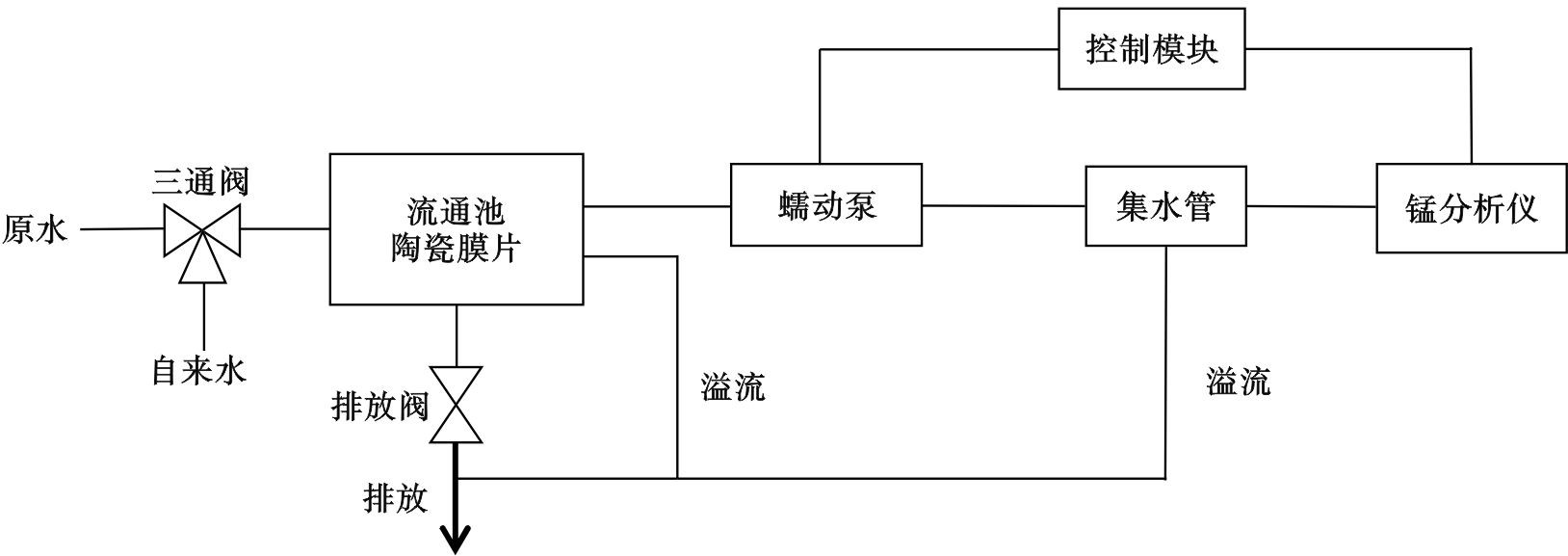-
锰是人体所必需的微量元素,广泛分布于人体内的肝脏、胰脏、肾脏等众多器官中,但过量的锰会引发呼吸系统疾病,浓度过高(5~10 mg/L)还会致死[1]。锰超标也会增加自来水的色度,及时去除锰能消除“黄水”现象。当锰含量超过0.3 mg/L时,水产生异味,严重影响人的感官[1]。《生活饮用水卫生标准:GB 5749—2022》中规定,出厂水锰的限值为0.1 mg/L[2]。锰和铁有相近的化学性质,但锰元素较铁元素更难以被氧化,因此饮用水除锰技术一直是饮用水保障的难点和热点[3]。传统去除锰的方法主要有曝气氧化、高锰酸钾氧化、氯氧化法、锰砂接触氧化和二氧化氯氧化[4-6]等。程永康等[7]分析传统除锰方法如曝气氧化和锰砂接触氧化等技术都需要对原水水质进行提高pH的处理,且去除锰的效率低下,存在较大局限性。而高锰酸钾氧化法既无副产物,也不用对水质进行pH预处理,在投药量少的情况下能达到较好的除锰效果。高锰酸钾反应水中二价锰反应,见式(1):
然而,高锰酸钾法的投加量控制是该法的难点。投加过量会导致“红水”,投加量不足则达不到除锰的效果。近年来,锰在线分析仪的开发和使用为解决这一难点提供了很好的思路和方法。目前在线锰分析仪中使用的方法均是分光光度法,主要为甲醛肟分光光度法和过硫酸铵分光光度法[8-10],虽然方法成熟,准确度高,但是其测的都是水中的总锰含量,无法直接准确测得二价锰含量,且水中的固态锰元素对测量结果存在较大的影响。
另外,水中的悬浮物、胶体、色度等会对吸光度产生影响,会导致数据偏高,在实际水样测定过程中严重影响数据的准确性。陶瓷膜主要由氧化铝、氧化硅等材料制成[11],按用途可分为微滤、超滤、纳滤、反渗透等[12]。与普通的预处理过滤器相比,陶瓷膜具有化学稳定性好、耐腐蚀性强、机械强度优、易清洗、通量高、孔径分布窄、分离性能好和使用寿命长等特点[7,10]。在应用上,陶瓷膜也有无二次使用风险、进水水质耐受范围广、抗污染性能好等优势[13-15]。因此,本文通过研究陶瓷膜预处理器应用于锰在线分析仪,在线监测二价锰离子变化情况,为较好地控制高锰酸钾的投量,提高饮用水中锰的去除效果提供技术支撑。
-
本研究选取某以一大型水库为水源水的水厂。根据多年来对该水库水质监测的数据分析发现,该水库每年1—4月份水质较好,水厂原水中未能监测到锰离子。从5月份开始,由于天气渐热,上层水体被温跃层隔开且缺少对流,下层水体处于缺氧环境,水库底泥中的固态锰被还原成溶解性的Mn2+析出,使下层水体含锰量大幅升高[5],最高可达1.2 mg/L。原水中锰含量一般于10月份达到峰值,10月末随着气温的下降明显下降,至11月份锰离子降低至标准水平。
该水库原水二价锰离子含量存在较大的波动性,单日内最高达0.20 mg/L波动,特别是出现台风、暴雨及季节转换时波动更大,4小时内由0.60降至0.20 mg/L左右。原水锰离子含量的波动给水厂运行中高锰酸钾的投加量控制带来了较大影响,实验室一般采用过硫酸铵分光光度法,人工检测周期长达1 h,如果要实现每个小时检测1次锰含量数据,则人工劳动成本较高,不易实现。故对原水二价锰离子含量的在线检测很有必要。
-
本次试验所使用的锰在线分析仪规格为0~20 mg/L,输出信号为4~20 mA,型号为Power Mon NG BL131+M340-01(布朗卢比,德国)。浊度测定使用的台式浊度仪型号为TU5200(哈希,美国)。陶瓷膜型号为TJ_CUF_0.1(天健,中国)。
-
本研究所使用的陶瓷膜预处理器装置,见图1。
主要部件包含三通阀、流通池、陶瓷膜片、蠕动泵、集水管、控制模块。其中,过滤模块采用孔径0.45 μm、机械强度高、寿命长的浸没式平板陶瓷膜;三通阀控制进水水源,当锰在线分析仪工作时,切换三通阀将进水切至原水,当锰在线分析仪不工作时,切换三通阀将进水切至自来水,可有效缓解原水中的杂质在膜表面富集,减轻陶瓷膜的压力;蠕动泵用于抽陶瓷膜产水,锰分析仪工作前,蠕动泵先工作,将过滤后的原水抽至集水管供仪表进水用,在线锰分析仪不工作时,蠕动泵停止工作,此时陶瓷膜也不工作,可大大减少陶瓷膜的运行时间,避免陶瓷膜的污堵,延长清洗周期;控制模块主要控制三通阀的切换及蠕动泵的运行。
-
实验室中采用过硫酸铵分光光度法检测锰含量。原理是在硝酸银的作用下,低价锰被过硫酸铵氧化成紫红色的高锰酸盐,在波长530 mm处测量吸光度,高锰酸盐的颜色深度与锰含量成正比[9],为了避免水样中的其他杂质对检测结果的影响,实验室中通常使用滤纸对水样进行过滤后再进行检测。
-
为了了解原水浑浊度对锰在线分析仪的影响,在不同浑浊度下将锰在线分析仪表与实验室使用过硫酸铵分光光度法所测数据进行对比,见表1。
表1可知,不同浑浊度下过硫酸铵分光光度法与锰在线分析仪测定锰含量的对比,误差率均超过10%,原水浑浊度>14.73 NTU时,误差率超过了15%,测定结果随着原水浑浊度的增加,误差值越大,说明浑浊度高的情况下会导致水样锰测定结果偏高,而且浑浊度越高,影响更大。水厂根据原水二价锰离子的含量来确定高锰酸钾投加量,其余水中不溶物是造成偏差的主要因素,进仪器前需要先排除。如果不排除则会使二价锰离子的检测结果产生偏差,如偏差过大则会使高锰酸钾投加量过大造成“红水”影响出厂水质。
-
为验证陶瓷膜对原水经预处理后的检测效果,本研究进行了多次的仪器测定比对,同一水样在经过陶瓷膜预处理器处理后,进行锰在线分析仪与实验室锰分析仪人工检测的数据比对,见表2。
表2可知,使用陶瓷膜预处理器后,锰在线分析仪测定结果与过硫酸铵分光光度法测定结果偏差在0.01~0.02 mg/L,误差率均<4%,平均误差率为3.3%,相比于不装预处理装置15%左右的误差率,有了明显的下降。可准确测定原水中二价锰含量。原水浑浊度的升高未对锰在线分析仪测定结果产生影响,保证了仪表的准确性。
为对比不同过滤设备预处理对锰在线分析仪检测结果的稳定性,寻找最合适的预处理器,我们采用锰在线分析仪将陶瓷膜预处理器与普通过滤器对同一原水水样进行了对比检测,从2021年的数据中随机抽取了连续8 d的检测数据,见表3。
表3可知,使用普通过滤器检测的锰含量与实验室检测时的偏差随着时间增加非常明显,而使用陶瓷膜预处理器后检测的偏差值随时间变化很少。使用普通过滤器测量值的漂移率为7.8%,而采用陶瓷膜预处理器测量值的漂移率仅为1.7%,相差6.1%。说明使用陶瓷膜预处理器后在线锰分析仪检测稳定性非常好。
-
该水厂根据实验室比对结果,在锰在线分析仪的前端安装了陶瓷膜预处理器。从2021年开始运行至今,发现原水锰含量的数据比较平稳,不再出现因原水中的杂质影响而出现检测结果突变的情况。检测结果的误差率由2020年的15%降低到2021年的3.3%,锰在线分析仪的仪表检测漂移率从2020年的7.8%降至2021年的1.7%,说明使用陶瓷膜预处理器后,锰在线分析仪的测量准确度和稳定性有了明显提高。陶瓷膜预处理器运行自动化程度高,可以实现自动反冲洗,保证过滤效果,无需太多的人工维护。
选取使用陶瓷膜预处理器和未使用陶瓷膜预处理器2个年份的高锰酸钾除锰离子实际效果作比较,可以发现有使用陶瓷膜预处理器对减少高锰酸钾的使用有明显的效果。2个年份5—10月原水的锰离子含量平均值分别为:0.214和0.215 mg/L,差别不大。使用陶瓷膜预处理器和未使用陶瓷膜预处理器2个年份的5—10月供水量分别为:6 480和6 210万m3,高锰酸钾的使用量分别为52和33 t。千吨水量高锰酸钾用量分别为0.801和0.531 kg/km3。出厂水水质锰离子含量平均值分别为0.004和0.001 mg/L。水质合格率为97.75%和99.57%,提高了近2%。通过比较,单位水量的高锰酸钾用量明显减少,而且水厂出厂水水质锰离子合格率明显提高。
-
作为锰在线分析仪的预处理一般都使用普通的过滤器来实现,存在过滤效果差导致仪表检测数据准确度低且不稳定,以及滤芯经常堵塞需要频繁更换等缺点。使用陶瓷膜预处理器后,检测仪表的数据非常稳定,而且准确率明显提高,陶瓷膜预处理器后还可以通过自动反洗,长期重复使用。该系统不仅可以作为在线锰分析仪的预处理系统,还可以作为绝大多数在线水质检测仪表的前级预处理系统。
陶瓷膜预处理器应用于锰在线分析仪的研究
Application of ceramic membrane preprocessor in manganese analyzer
-
摘要: 水库原水作为水厂水源在夏季经常出现铁、锰离子超标情况。原水中的锰离子一般采用高锰酸钾氧化法进行去除。水厂通过安装锰在线分析仪掌握原水中二价锰离子变化情况,进而确定高锰酸钾投加量。文章分析了陶瓷膜预处理器在提高锰在线分析仪数据准确性方面的适用性及处理效果。结果表明,使用陶瓷膜预处理器进行预处理后,锰在线分析仪检测准确度和稳定性有了显著提高,检测结果误差率由15.4%降至3.3%,检测结果漂移率从7.8%降至1.7%。原水锰离子检测精度的提高,优化并降低了水厂高锰酸钾用量,提高了出厂水锰离子合格率。Abstract: As the source of the water plant, the raw water of the reservoir often has excessive iron and manganese ions in summer. Manganese ions in raw water are generally removed by potassium permanganate oxidation. The water plant mastered the change of divalent manganese ions in raw water by installing a manganese online analyzer and then determined the dosage of the potassium permanganate. The applicability and treatment effect of ceramic membrane preprocessors in improving the data accuracy of the manganese online analyzer were analyzed. The results showed that the accuracy and stability of the manganese online analyzer were significantly improved after the pretreatment with the ceramic membrane preprocessor. The error rate of the test results was reduced from 15.4% to 3.3%, and the drift rate of the test results was reduced from 7.8% to 1.7%. The improvement of the detection accuracy of raw water manganese ions optimized and reduced the amount of potassium permanganate in the water plant, and improves the qualified rate of manganese ions in the finished water.
-

-
表 1 不同浑浊度下过硫酸铵分光光度法与锰在线分析仪测定锰含量的对比
Table 1. Comparison between ammonium persulfate spectrophotometry and manganese online analyzer for determining manganese content under different turbidity levels
浊度/
NTU测得锰含量/mg·L−1 误差值 误差
率/%锰在线分析仪 过硫酸铵分光光度法 20.46 0.604 0.482 0.122 20.20 14.73 0.554 0.470 0.084 15.16 10.55 0.518 0.456 0.062 11.97 8.08 0.453 0.397 0.056 12.36 7.07 0.366 0.321 0.045 12.30 2.87 0.410 0.364 0.046 11.22 2.24 0.379 0.336 0.043 11.35 1.81 0.337 0.302 0.035 10.39 表 2 过硫酸铵分光光度法与锰在线分析仪测定锰含量结果对比
Table 2. Comparison of results between ammonium persulfate spectrophotometry and manganese online analyzer for determining manganese content
浊度/
NTU测得锰含量/mg·L−1 误差值 误差
率/%锰在线分析仪 过硫酸铵分光光度法 20.46 0.493 0.482 0.011 2.23 14.73 0.401 0.386 0.015 3.74 10.55 0.474 0.456 0.018 3.80 8.08 0.411 0.397 0.014 3.41 7.07 0.333 0.321 0.012 3.60 2.87 0.375 0.364 0.011 2.93 2.24 0.349 0.336 0.013 3.72 1.81 0.337 0.326 0.011 3.26 表 3 使用陶瓷膜预处理器与普通过滤器下锰在线分析仪对锰含量测定结果对比
Table 3. Comparison of the results of manganese content measurement using ceramic membrane pre-processor and manganese online analyzer under the ordinary filter
检测日期 过硫酸铵分光光度法
测得锰含量/mg·L−1锰在线分析仪测得锰含量 普通过滤器/mg·L−1 误差值 误差率/% 陶瓷膜预处理器/mg·L−1 误差值 误差率/% 2021-07-01 0.323 0.334 0.011 3.41 0.333 0.010 3.10 2021-07-02 0.326 0.342 0.016 4.91 0.337 0.011 3.37 2021-07-03 0.329 0.343 0.014 4.20 0.34 0.011 3.34 2021-07-04 0.335 0.358 0.023 6.87 0.347 0.012 3.58 2021-07-05 0.346 0.376 0.030 8.67 0.359 0.013 3.76 2021-07-06 0.352 0.389 0.037 10.51 0.365 0.013 3.69 2021-07-07 0.355 0.393 0.038 10.70 0.369 0.014 3.94 2021-07-08 0.358 0.398 0.040 11.17 0.372 0.014 3.91 -
[1] 李欣. 饮用水除锰技术研究进展与展望[J]. 农业与技术, 2022, 42(3): 86 − 89. [2] 国家市场监督管理总局, 国家标准化管理委员会. 生活饮用水卫生标准: GB 5749—2022[S]. 北京: 中国标准出版社, 2022. [3] 袁烁, 刘树元, 郑晨等. 饮用水中除锰技术的研究进展[J]. 台州学院学报, 2015, 37(3): 52 − 59. [4] 彭明霞. 论水库水质铁锰超标原因分析及污染防治措施[J]. 环境与发展, 2018, 30(5): 51 − 53. [5] 林业, 练伟雄. 自来水厂锰超标处理方法及生产实践[J]. 城镇供水, 2021, 219(1): 47 − 51. [6] 许谦. 某水厂出厂水锰超标应急处理案例[J]. 净水技术2020, 39(6): 173-174. [7] 程永康, 王锡良, 张含斌, 等. 水库水锰超标去除方法及高锰酸钾除锰[J]. 净水技术, 2021, 40(S2): 76 − 79. [8] 程莉, 魏小红, 张加玲. 甲醛肟分光光度法测定生活饮用水中锰方法的改进[J]. 中国卫生检验杂志, 2013, 23(6): 1607-1608. [9] 国家市场监督管理总局, 国家标准化管理委员会. 生活饮用水标准检验方法: GB 5750.6-2023[S]. 北京: 中国标准出版社, 2023. [10] 成小翔, 梁恒. 陶瓷膜饮用水处理技术发展与展望[J]. 哈尔滨工业大学学报, 2016, 48(8): 1 − 10. [11] 李潇洒. 陶瓷膜在饮用水处理中的应用和发展[J]. 陶瓷, 2021, 431(9): 96 − 97. [12] 秦伟伟, 宋永会, 肖书虎, 等. 陶瓷膜在水处理中的发展与应用[J]. 工业水处理, 2011, 31(10): 15 − 19. [13] 钱灏, 张平允, 叶辉, 等. 陶瓷膜应用于饮用水处理市场的分析及展望[J]. 给水排水, 2023, 59(1): 142 − 149. [14] 徐梦甜, 胡皓, 傅婉芝. 两种分光光度法测定水中锰含量的对比研究[J]. 皮革制作与环保科技, 2022, 3(1): 51 − 53. [15] 杨文建, 郭庆, 段冬, 等. 陶瓷膜在饮用水处理中的应用与膜污染控制[J]. 陶瓷, 2022, 435(1): 144 − 145. -




 下载:
下载:

